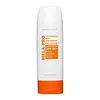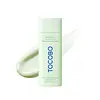What's inside
What's inside
 Key Ingredients
Key Ingredients

 Benefits
Benefits

 Concerns
Concerns

 Ingredients Side-by-side
Ingredients Side-by-side

Water
Skin ConditioningCaprylic/Capric Triglyceride
MaskingGlycereth-26
HumectantEthylhexyl Methoxycinnamate
UV AbsorberEthylhexyl Salicylate
UV AbsorberDimethicone
EmollientBis-Ethylhexyloxyphenol Methoxyphenyl Triazine
Skin ConditioningTitanium Dioxide
Cosmetic ColorantPolysorbate 60
EmulsifyingNiacinamide
SmoothingTranexamic Acid
AstringentGlyceryl Stearate
EmollientPEG-100 Stearate
Dipropylene Glycol
HumectantHydroxyethyl Acrylate/Sodium Acryloyldimethyl Taurate Copolymer
Emulsion StabilisingHydroxyacetophenone
AntioxidantC12-16 Alcohols
EmollientSorbitan Sesquioleate
EmulsifyingCyclopentasiloxane
EmollientAluminum Hydroxide
EmollientCaprylyl Glycol
EmollientSodium Polyacrylate
AbsorbentHydrogenated Lecithin
EmulsifyingEthylhexyl Stearate
EmollientStearic Acid
CleansingPalmitic Acid
EmollientHydrogen Dimethicone
Xanthan Gum
EmulsifyingDimethicone/Vinyl Dimethicone Crosspolymer
Skin ConditioningSorbitan Isostearate
EmulsifyingTrideceth-6
EmulsifyingDisodium EDTA
Dipotassium Glycyrrhizate
HumectantParfum
MaskingWater, Caprylic/Capric Triglyceride, Glycereth-26, Ethylhexyl Methoxycinnamate, Ethylhexyl Salicylate, Dimethicone, Bis-Ethylhexyloxyphenol Methoxyphenyl Triazine, Titanium Dioxide, Polysorbate 60, Niacinamide, Tranexamic Acid, Glyceryl Stearate, PEG-100 Stearate, Dipropylene Glycol, Hydroxyethyl Acrylate/Sodium Acryloyldimethyl Taurate Copolymer, Hydroxyacetophenone, C12-16 Alcohols, Sorbitan Sesquioleate, Cyclopentasiloxane, Aluminum Hydroxide, Caprylyl Glycol, Sodium Polyacrylate, Hydrogenated Lecithin, Ethylhexyl Stearate, Stearic Acid, Palmitic Acid, Hydrogen Dimethicone, Xanthan Gum, Dimethicone/Vinyl Dimethicone Crosspolymer, Sorbitan Isostearate, Trideceth-6, Disodium EDTA, Dipotassium Glycyrrhizate, Parfum
Water
Skin ConditioningDibutyl Adipate
EmollientButyloctyl Salicylate
Skin ConditioningButylene Glycol
HumectantEthylhexyl Triazone
UV AbsorberTerephthalylidene Dicamphor Sulfonic Acid
UV AbsorberBis-Ethylhexyloxyphenol Methoxyphenyl Triazine
Skin ConditioningPolyglyceryl-3 Distearate
EmulsifyingNiacinamide
SmoothingPolymethylsilsesquioxane
Tromethamine
Buffering1,2-Hexanediol
Skin ConditioningDiethylamino Hydroxybenzoyl Hexyl Benzoate
UV FilterCetearyl Alcohol
EmollientPentylene Glycol
Skin ConditioningPolysilicone-15
UV FilterHydrolyzed Safflower Flower Extract
Skin ConditioningGardenia Taitensis Callus Extract
AntioxidantCentella Asiatica Root Extract
Skin ConditioningCentella Asiatica Leaf Extract
Skin ConditioningCentella Asiatica Extract
CleansingAloe Ferox Leaf Extract
Skin ConditioningSodium Hyaluronate
HumectantSodium Polyacryloyldimethyl Taurate
Emulsion StabilisingGlyceryl Stearate
EmollientPotassium Cetyl Phosphate
EmulsifyingPoly C10-30 Alkyl Acrylate
Emulsion StabilisingGlycerin
HumectantPolyacrylate Crosspolymer-6
Emulsion StabilisingGlyceryl Stearate Citrate
EmollientInulin Lauryl Carbamate
Emulsion StabilisingAmmonium Acryloyldimethyltaurate/Vp Copolymer
Ethylhexylglycerin
Skin ConditioningAdenosine
Skin ConditioningDextrin
AbsorbentTocopherol
AntioxidantSaccharomyces Ferment Filtrate
HumectantDimethylsilanol Hyaluronate
HumectantHydrolyzed Sodium Hyaluronate
Skin ConditioningZinc Hydrolyzed Hyaluronate
HumectantPotassium Hyaluronate
Skin ConditioningHyaluronic Acid
HumectantAsiaticoside
AntioxidantSodium Hyaluronate Crosspolymer
HumectantHydroxypropyltrimonium Hyaluronate
Madecassoside
AntioxidantSodium Hyaluronate Dimethylsilanol
HumectantSodium Acetylated Hyaluronate
HumectantMadecassic Acid
Skin ConditioningAsiatic Acid
Skin ConditioningParfum
MaskingWater, Dibutyl Adipate, Butyloctyl Salicylate, Butylene Glycol, Ethylhexyl Triazone, Terephthalylidene Dicamphor Sulfonic Acid, Bis-Ethylhexyloxyphenol Methoxyphenyl Triazine, Polyglyceryl-3 Distearate, Niacinamide, Polymethylsilsesquioxane, Tromethamine, 1,2-Hexanediol, Diethylamino Hydroxybenzoyl Hexyl Benzoate, Cetearyl Alcohol, Pentylene Glycol, Polysilicone-15, Hydrolyzed Safflower Flower Extract, Gardenia Taitensis Callus Extract, Centella Asiatica Root Extract, Centella Asiatica Leaf Extract, Centella Asiatica Extract, Aloe Ferox Leaf Extract, Sodium Hyaluronate, Sodium Polyacryloyldimethyl Taurate, Glyceryl Stearate, Potassium Cetyl Phosphate, Poly C10-30 Alkyl Acrylate, Glycerin, Polyacrylate Crosspolymer-6, Glyceryl Stearate Citrate, Inulin Lauryl Carbamate, Ammonium Acryloyldimethyltaurate/Vp Copolymer, Ethylhexylglycerin, Adenosine, Dextrin, Tocopherol, Saccharomyces Ferment Filtrate, Dimethylsilanol Hyaluronate, Hydrolyzed Sodium Hyaluronate, Zinc Hydrolyzed Hyaluronate, Potassium Hyaluronate, Hyaluronic Acid, Asiaticoside, Sodium Hyaluronate Crosspolymer, Hydroxypropyltrimonium Hyaluronate, Madecassoside, Sodium Hyaluronate Dimethylsilanol, Sodium Acetylated Hyaluronate, Madecassic Acid, Asiatic Acid, Parfum
 Reviews
Reviews

Ingredients Explained
These ingredients are found in both products.
Ingredients higher up in an ingredient list are typically present in a larger amount.
You might know this ingredient as Tinosorb S or Bemotrizinol. It is a UV filter that covers both UVA and UVB rays.
This ingredient has two peak UV absorption peaks ( 310 and 340 nm) and is able to absorb both UV-A and UV-B rays. This ingredient works by preventing UV rays from reaching and damaging your skin.
On top of that - it is highly photostable and helps prevent the photodegration of other sunscreen ingredients such as avobenzone.
Tinosorb S is allowed in the EU, Australia, and Asia. It is close to being approved by the FDA and we'll hopefully get this ingredient in the U.S. by late 2025.
Fun fact: Tinosorb S is the most effective UV absorber at maximum concentration (measured by SPF) permitted in the EU.
This ingredient is oil-soluble, so your oil-cleansers will take this right off at night.
Learn more about Bis-Ethylhexyloxyphenol Methoxyphenyl TriazineGlyceryl Stearate is a mix of glycerin and stearic acid.
It is used to stabilize the mixing of water and oil ingredients. By preventing these ingredients from separating, it can help elongate shelf life. It can also help thicken the product's texture.
As an emollient, it helps soften skin and supports barrier-replenishing ingredients.
In cosmetics, Glyceryl Stearate is often made from vegetable oils or synthetically produced.
This ingredient may not be fungal-acne safe
Fun fact: The human body also creates Glyceryl Stearate naturally.
Learn more about Glyceryl StearateNiacinamide is a multitasking form of vitamin B3 that strengthens the skin barrier, reduces pores and dark spots, regulates oil, and improves signs of aging.
And the best part? It's gentle and well-tolerated by most skin types, including sensitive and reactive skin.
You might have heard of "niacin flush", or the reddening of skin that causes itchiness. Niacinamide has not been found to cause this.
In very rare cases, some individuals may not be able to tolerate niacinamide at all or experience an allergic reaction to it.
If you are experiencing flaking, irritation, and dryness with this ingredient, be sure to double check all your products as this ingredient can be found in all categories of skincare.
When incorporating niacinamide into your routine, look out for concentration amounts. Typically, 5% niacinamide provides benefits such as fading dark spots. However, if you have sensitive skin, it is better to begin with a smaller concentration.
When you apply niacinamide to your skin, your body converts it into nicotinamide adenine dinucleotide (NAD). NAD is an essential coenzyme that is already found in your cells as "fuel" and powers countless biological processes.
In your skin, NAD helps repair cell damage, produce new healthy cells, support collagen production, strengthen the skin barrier, and fight environmental stressors (like UV and pollution).
Our natural NAD levels start to decline with age, leading to slower skin repair, visible aging, and a weaker skin barrier. By providing your skin niacinamide, you're recharging your skin's NAD levels. This leads to stronger, healthier, and younger looking skin.
Another name for vitamin B3 is nicotinamide. This vitamin is water-soluble and our bodies don't store it. We obtain Vitamin B3 from either food or skincare. Meat, fish, wheat, yeast, and leafy greens contain vitamin B3.
The type of niacinamide used in skincare is synthetically created.
Learn more about NiacinamideParfum is a catch-all term for an ingredient or more that is used to give a scent to products.
Also called "fragrance", this ingredient can be a blend of hundreds of chemicals or plant oils. This means every product with "fragrance" or "parfum" in the ingredients list is a different mixture.
For instance, Habanolide is a proprietary trade name for a specific aroma chemical. When used as a fragrance ingredient in cosmetics, most aroma chemicals fall under the broad labeling category of “FRAGRANCE” or “PARFUM” according to EU and US regulations.
The term 'parfum' or 'fragrance' is not regulated in many countries. In many cases, it is up to the brand to define this term.
For instance, many brands choose to label themselves as "fragrance-free" because they are not using synthetic fragrances. However, their products may still contain ingredients such as essential oils that are considered a fragrance by INCI standards.
One example is Calendula flower extract. Calendula is an essential oil that still imparts a scent or 'fragrance'.
Depending on the blend, the ingredients in the mixture can cause allergies and sensitivities on the skin. Some ingredients that are known EU allergens include linalool and citronellol.
Parfum can also be used to mask or cover an unpleasant scent.
The bottom line is: not all fragrances/parfum/ingredients are created equally. If you are worried about fragrances, we recommend taking a closer look at an ingredient. And of course, we always recommend speaking with a professional.
Learn more about ParfumWater. It's the most common cosmetic ingredient of all. You'll usually see it at the top of ingredient lists, meaning that it makes up the largest part of the product.
So why is it so popular? Water most often acts as a solvent - this means that it helps dissolve other ingredients into the formulation.
You'll also recognize water as that liquid we all need to stay alive. If you see this, drink a glass of water. Stay hydrated!
Learn more about Water